Your Guide to an Interior Design App Online
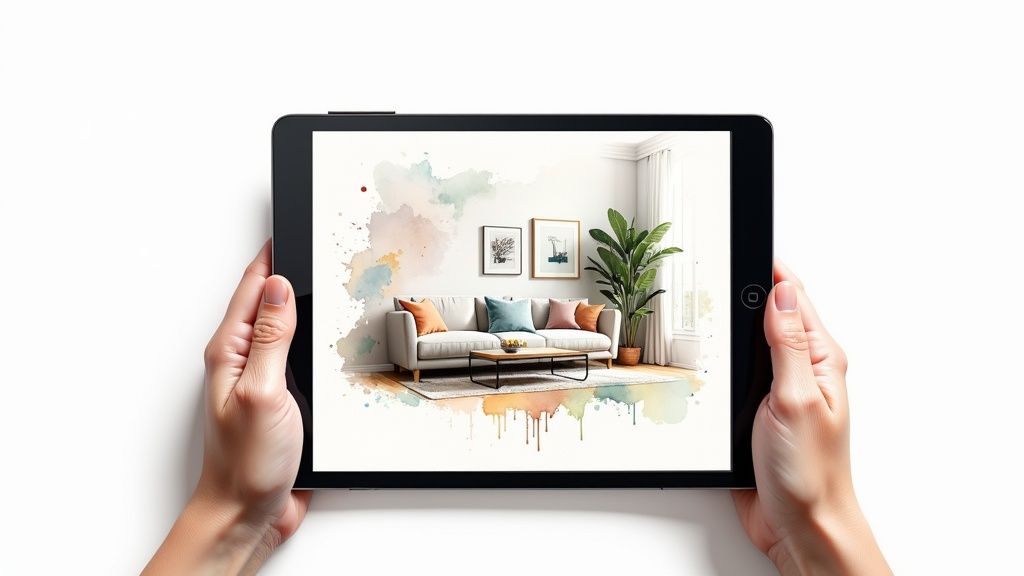
An interior design app is basically a digital sandbox for your home. It’s a tool that lets you play around with decor, layouts, and even major remodels on your computer or tablet—all before you have to spend a single dime or lift a hammer. Think of it as a risk-free way to test drive your design ideas.
Bring Your Dream Home to Life with Digital Tools
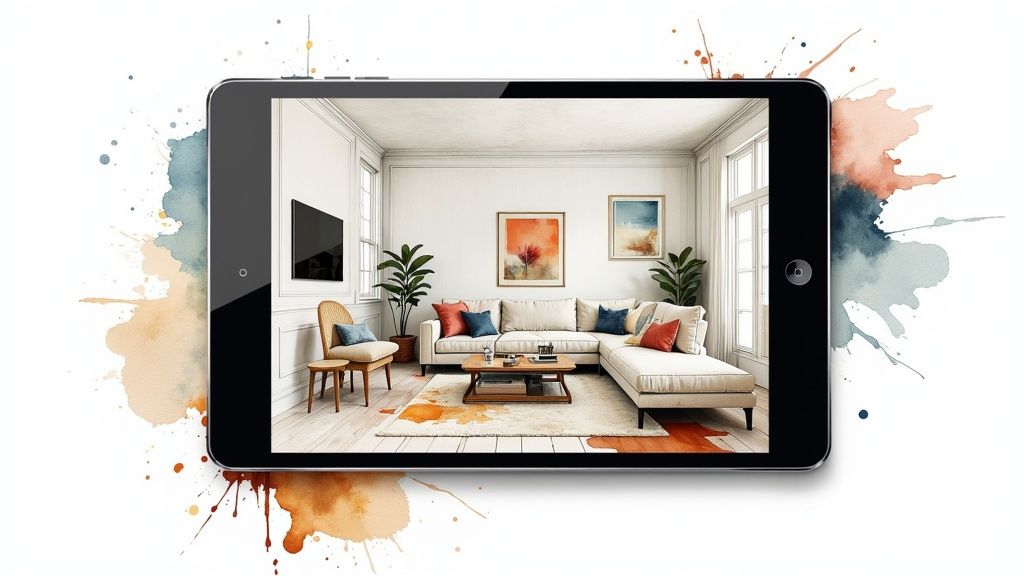
Staring at an empty room can feel like both a huge opportunity and a massive headache. You can picture it in your head, but actually turning that vision into a real, functional space? That’s where things get complicated and, frankly, expensive. This is exactly where an online interior design app can become your best friend, essentially handing you a professional designer’s toolkit.
These powerful platforms take the mystery out of the design process. They help you move past just pinning ideas and actually see what works in a matter of minutes. No more guessing if that sofa will fit through the door or if that bold paint color will be overwhelming. You’ll just know.
A Modern Approach to Home Design
At their heart, these tools are built to close the gap between your imagination and reality. They create a space where you can be creative but also make smart, confident decisions about your home. Some of the biggest wins include:
- Visualizing Before Committing: See exactly how that new sectional or area rug will look in your actual room, helping you avoid those “what was I thinking?” purchase mistakes.
- Experimenting Freely: Ever wondered about a dark, moody accent wall? Try it out. Want to see if the TV works better on the other side of the room? Go for it. You can test wild ideas without the mess or the cost.
- Streamlining Planning: You can create surprisingly accurate floor plans and layouts, making sure everything not only fits but flows together beautifully.
This move toward digital design is no small trend. The global interior design software market was valued at around USD 5.37 billion and is expected to hit nearly USD 9.66 billion by 2030. That growth is all about people like you wanting more control and better tools for home projects.
The true power of an online design app is its ability to give you permission to be creative. It removes the fear of making a mistake, which often paralyzes homeowners and prevents them from creating a space they truly love.
Of course, great design isn’t just about the big picture; it’s about making every corner of your home work for you. For more focused projects, you can find great advice on topics like how to design a closet for perfect organization to maximize every inch of space.
What Is an Interior Design App and How Does It Work?
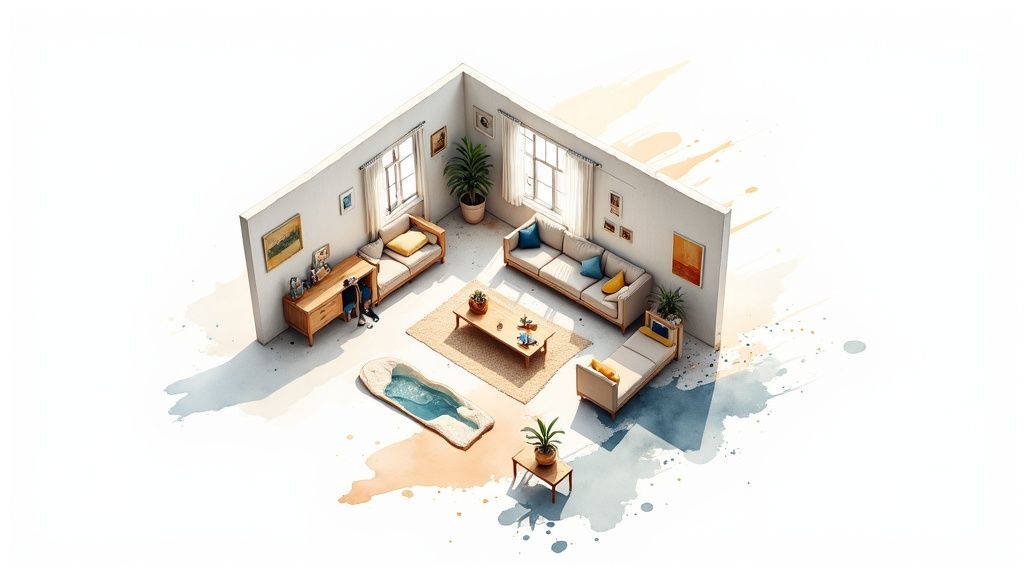
Think of an online interior design app as your personal design sandbox. It’s a virtual playground where you can test-drive your wildest home decor ideas without the mess, the cost, or the back-breaking work of moving furniture around.
At its heart, an interior design app is all about one thing: visualization. It gives you the power to see exactly how your space will look before you ever pick up a paintbrush or spend a dime. That’s what makes these tools so invaluable for any project, from a simple bedroom refresh to a full-blown renovation.
From Blueprint to Virtual Reality
So, how does it actually work? Most apps start by having you create a digital twin of your room. You might upload a photo of the space, sketch out a floor plan, or simply punch in the exact dimensions. This creates the basic canvas you’ll work on.
Once your digital room is set up, the real magic happens. You get to bring it to life by adding furniture, colors, and finishes.
- Test Paint and Materials: Instantly swap out wall colors with a click. Want to see how that dark green you’ve been eyeing looks? Done. Curious about hardwood versus tile for the floor? You can compare them side-by-side in seconds.
- Arrange Furniture: Drag and drop sofas, beds, and tables from huge digital catalogs to find the perfect placement. You can check for flow, make sure everything fits, and avoid costly mistakes.
- Experiment with Layouts: Ever wonder if knocking down a wall would open up your living room? In the app, you can do it virtually and see the results instantly, no sledgehammer required.
The real power of an online design tool is its ability to make your ideas tangible. It takes the guesswork—and the risk—out of decorating.
This freedom to play and experiment is a total game-changer. If you want to see how different platforms stack up, our guide on online interior design tools breaks it down even further.
Making Confident Design Decisions
Ultimately, an interior design app acts as the bridge between your imagination and reality. By giving you a photorealistic preview of your final design, it lets you move forward with total confidence.
You can tweak and refine your plan until it’s perfect. This means that when it’s time to actually buy that sofa or paint that wall, you aren’t just crossing your fingers and hoping for the best. You already know it’s going to look amazing. It turns a stressful process into a fun, creative adventure.
What Can You Actually Do With a Modern Design App?
At their heart, today’s best design apps are packed with a suite of features designed to turn a complex, often frustrating process into something intuitive and even fun. These tools aren’t just for making simple mood boards; they are powerful simulators for your home. Let’s break down the core features that make any interior design app online so effective.
A solid plan is the bedrock of any good design, and that’s where 2D floor planning comes in. This isn’t just about sketching rough lines on a screen. It’s about creating a precise, to-scale blueprint of your space, ensuring every measurement—from wall lengths to the exact placement of doors and windows—is accurate. Guesswork is eliminated from day one.
Bringing Your Blueprint to Life
Once you have your 2D blueprint, the real magic begins: bringing it into the third dimension. 3D visualization is the feature that transforms that flat floor plan into a dynamic, walkable virtual model of your room. It’s here that you can truly get a feel for the space, understanding its flow and proportions in a way a simple drawing never could.
The impact of this technology is huge. In fact, 3D interior design software now dominates the market, accounting for over 56% of the industry’s total revenue. This growth highlights just how essential realistic visualization has become for homeowners and professionals. You can dive deeper into these market dynamics and growth trends in the full industry report on Mordor Intelligence.
The power of 3D visualization lies in its ability to answer the question, “How will this actually feel?” It closes the gap between an abstract idea and a tangible reality, giving you the confidence to make bold design choices.
Your Endless Digital Showroom
With your virtual room built, it’s time for the best part: furnishing it. This is where material and furniture libraries become your greatest asset. Imagine having a massive, endless digital showroom at your fingertips, filled with thousands of real-world items.
- Furniture Catalogs: You can browse and place sofas, tables, chairs, and beds from actual brands directly into your design to see how they fit and if they match your style.
- Material Palettes: Instantly test out different paint colors, wallpapers, and flooring types like hardwood or tile. You can even swap out countertop finishes with a single click.
- Decor and Accessories: Add the all-important finishing touches. Place virtual rugs, lamps, plants, and art to complete the look and make the space feel truly lived-in.
The image below shows how access to these extensive libraries often differs between free and paid versions of an app.
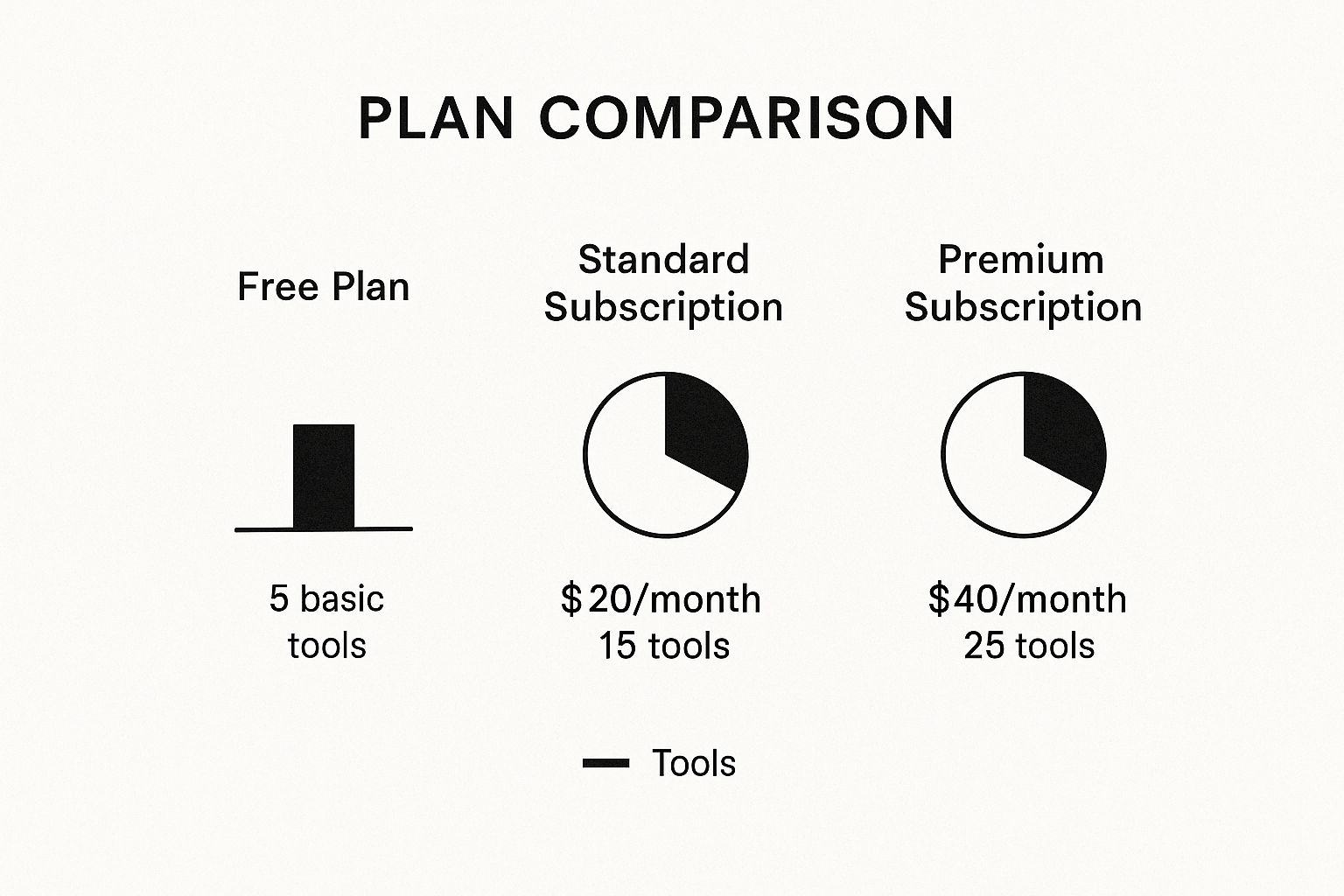
As you can see, free plans are great for getting your feet wet, but paid subscriptions are what really unlock the full creative potential with a much wider array of features and assets.
Finally, many apps now have AI built-in to offer intelligent suggestions. This feature acts like a personal design assistant, analyzing your style preferences to recommend layouts, color schemes, and furniture pairings, making expert-level guidance accessible to everyone.
To really see the difference, let’s compare the old way of doing things with the new.
Traditional Design vs Online App Features
| Design Stage | Traditional Method | Online App Solution |
|---|---|---|
| Floor Planning | Hand-drawn sketches, measuring tape, and professional drafts. Often slow and prone to error. | 2D Floor Planner: Create precise, to-scale digital blueprints in minutes. Easily make changes on the fly. |
| Visualization | Mood boards, fabric swatches, and a lot of imagination. Hard to see the final picture. | 3D Visualization: Walk through a photorealistic model of your room. Instantly see how everything looks together. |
| Sourcing Furniture | Visiting multiple stores, collecting catalogs, and hoping items fit and match. | Furniture & Material Libraries: Access thousands of real items from brands. Drag and drop to test fit, style, and color. |
| Getting Feedback | Presenting plans to family or clients, followed by slow, manual revisions. | AI-Powered Suggestions & Sharing: Get instant AI recommendations and easily share links to your 3D designs for quick feedback. |
This table makes it clear: what once took weeks of manual effort can now be accomplished in a single afternoon with far more accuracy and creative freedom.
The Real-World Benefits of Designing Your Home Online
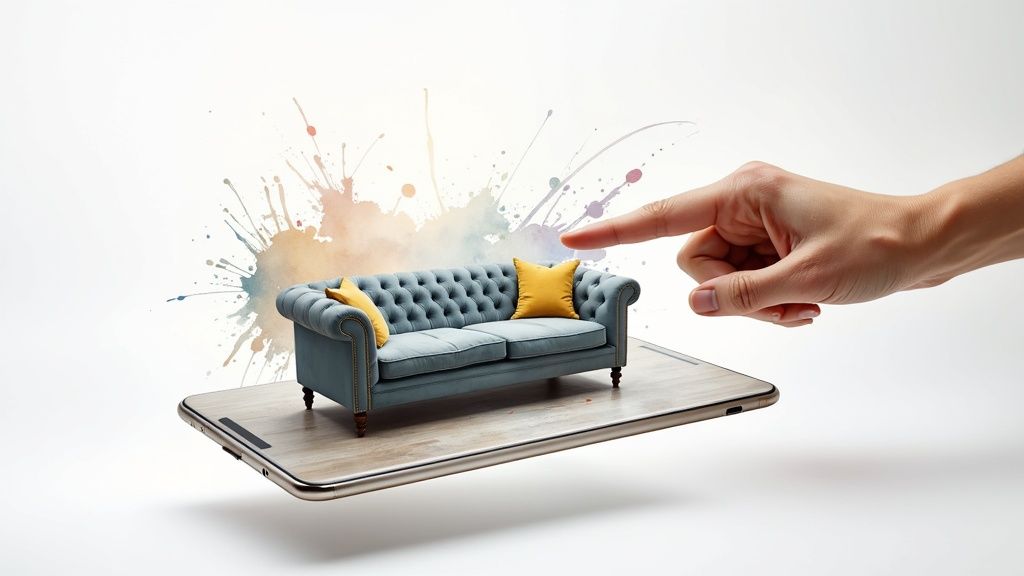
So, why bother with an interior design app online? It turns out these tools offer some pretty solid advantages that go way beyond just playing around with digital furniture. They solve some of the biggest headaches that come with decorating a home, focusing on three key areas: preventing expensive mistakes, sparking your creativity, and making sure everyone is on the same page.
Think of these apps as a financial safety net for your design project. We’ve all been there—that moment of “buyer’s remorse” when the furniture you loved in the store looks completely wrong in your space. By letting you visualize everything first, you can see if that oversized sofa will actually fit or if that trendy paint color clashes with your floors. It’s the digital version of “measure twice, cut once,” and it saves a ton of time and money.
Unlock Your Creative Potential
Here’s where the real fun begins. Using an app gives you total freedom to experiment without any real-world consequences. Let’s be honest, hesitation often gets the best of us. You might be dreaming of a dramatic accent wall or a funky furniture layout, but the fear of messing it up holds you back. An online design tool completely removes that risk.
It’s your own personal design playground. Want to try out a wild idea? Go for it. You can explore styles you’d never be brave enough to try in real life. You can even see how small changes make a big impact, like learning how to cover a couch for a flawless new look, before you commit to buying anything.
An interior design app is your personal creative laboratory. It gives you permission to make mistakes, which is where the best and most personal design ideas often originate.
Improve Collaboration and Clarity
Let’s face it, a design project is rarely a solo mission. Trying to get a partner, family member, or contractor to see the vision in your head is one of the toughest parts of any renovation. Vague descriptions and different interpretations are a recipe for frustration.
An interior design app cuts right through the confusion by providing a single, clear picture for everyone to look at. Instead of trying to explain what you mean, you can just show them a photorealistic 3D model of the room. Suddenly, everybody gets it.
- For Partners and Family: No more arguments over abstract ideas. You can share concepts, get immediate feedback, and make decisions together so the final space works for everyone.
- For Contractors and Painters: A visual plan is worth a thousand words. You can show them exactly where that light fixture goes or which wall gets the accent color, leaving no room for error.
This shared visual language gets rid of all the guesswork. When everyone can see the same plan, the entire process runs smoother, and you end up with a finished room that actually looks the way you imagined it.
How to Choose the Right Interior Design App for You
With so many options on the market, picking the right interior design app online can feel like a project in itself. The thing is, not all apps are created equal. Finding the one that clicks with your goals and skills is the secret to getting a great result.
Think of it like choosing the right tool for a job. You wouldn’t use a sledgehammer to hang a picture frame, right? The same logic applies here.
Start with a Gut Check on Your Needs
First, be honest about your own tech-savviness. Some apps are wonderfully simple, with easy drag-and-drop features perfect for a total beginner. Others are packed with more complex tools that are great for professionals or hobbyists who already know their way around design software.
Next, think about what you’re actually trying to accomplish. Are you just playing with new paint colors for the living room, or are you gutting the kitchen and starting from scratch?
- Ease of Use: If this is your first time dabbling in digital design, look for an app with a clean, simple layout. You want a tool that gets out of your way and lets you create, not one that makes you hunt through menus for an hour.
- Advanced Features: For bigger, more detailed projects, you’ll want more firepower. Things like precise measurement tools, the ability to upload your own textures, and realistic lighting controls can make or break a complex design.
The best app is one that feels like an extension of your own creativity. It should make bringing your ideas to life easier, not harder, no matter your skill level.
Look at the Quality of the Tools and Visuals
The heart of any design app is its library of digital items. A huge furniture and material library stocked with real products from actual brands is a game-changer. It means that the beautiful sofa you place in your virtual room can become a real sofa in your actual room, saving you the headache of trying to find a look-alike.
Just as important is how good the final picture looks. A simple 2D floor plan is useful for arranging furniture, but a stunning, photorealistic 3D rendering is what really sells the vision. It helps you feel what it’s like to stand in the room, see how the morning sun hits the floor, and notice how different fabrics look next to each other. If you want to learn more about this, we did a deep dive into what makes a great virtual room design app.
Finally, let’s talk about money. Many apps offer a free version with the basics, then ask you to pay for the premium features. Figure out your budget and decide if things like ultra-high-resolution images or access to exclusive furniture collections are worth it for your project. Weighing these factors will help you find the perfect digital partner for your design journey.
Meet RoomGenius: Your AI Design Partner
Now that we’ve covered what makes a great interior design app online, let’s talk about a tool that pulls all those features together—and then adds a layer of intelligence. RoomGenius isn’t just another platform for dragging and dropping furniture. Think of it more like an AI-powered partner that helps you skip straight to the fun part of designing.
Picture this: you have a living room that’s either completely empty or just plain outdated. Instead of staring at a blank screen and getting overwhelmed, you just snap a photo and upload it. Within minutes, the AI has analyzed your room’s layout, lighting, and size, and it starts generating fully furnished design concepts right in front of you.
From Blank Space to Dream Place in a Flash
This AI-first approach completely changes the game. It moves past the tedious manual work and gives you professional-looking, curated suggestions that actually fit your space and style. You can instantly see your room reimagined as a modern minimalist haven, a cozy bohemian retreat, or anything in between—all with coordinated colors and perfectly scaled furniture.
It really is that simple:
- Upload a Photo: Just start with a picture of your room.
- Pick Your Style: Let the AI know what kind of vibe you’re going for.
- Get Your Designs: Instantly receive multiple, unique design options.
- Refine and Shop: Fine-tune the designs you love and browse shoppable furniture suggestions.
This kind of smart technology is at the heart of a huge industry shift. The AI in interior design market is currently valued at USD 829 million, and it’s expected to rocket to over USD 7.3 billion by 2033. For a deeper dive into this incredible growth, take a look at this detailed market analysis on market.us.
RoomGenius tackles the biggest hurdle in any design project: decision fatigue. It gives you instant, high-quality inspiration, turning a sea of overwhelming choices into a clear and exciting starting point.
Ultimately, RoomGenius puts professional-grade design within everyone’s reach. To see how this technology stacks up against other digital tools, check out our guide on AI interior design software. It’s the perfect solution for anyone with a great vision who just needs a little help bringing it all together.
Common Questions About Interior Design Apps
Jumping into an interior design app online for the first time? It’s totally normal to have a few questions. This is a whole new way to think about your space, so let’s tackle some of the most common things people wonder about before they get started.
One of the biggest hang-ups is skill. A lot of people worry they need some kind of design background to make these tools work for them.
Can I Use These Apps With Zero Experience?
You absolutely can. In fact, the best apps out there are made with total beginners in mind.
They’re designed to be intuitive, often using simple drag-and-drop controls that feel more like playing a game than working with complex software. You don’t need to be a tech wizard—you just need an idea you want to bring to life. The app handles the heavy lifting, guiding you through the process and turning a technical task into a fun, creative one.
Another common question is about how a digital plan translates to your actual room. A great-looking design on screen is worthless if the furniture doesn’t actually fit.
The point of a good design app isn’t just to make pretty pictures. It’s to give you a reliable blueprint for your real home. Accuracy is a core feature, not a bonus.
How Accurate Are the Measurements?
Surprisingly accurate. As long as you feed the app the correct dimensions for your room to start, it will maintain that scale for every single object you place.
This lets you see with confidence whether that new sofa will block a doorway or if you’ll have enough space to walk around your dining table. Just remember the golden rule: double-check your own tape measure readings before you begin.
Finally, let’s talk about money. You see the word “free” thrown around a lot with these apps, but what does that really mean?
Are Online Design Apps Completely Free?
It depends on the app. Most run on a freemium model, which means you get access to the basics—like 2D floor plans and a starter library of furniture—at no cost. This is perfect for trying things out or for a simple layout project.
If you want the more powerful tools, like photorealistic 3D renderings or access to a massive catalog of real-world products, you’ll usually need to upgrade to a paid plan. Think of the free version as the test drive and the paid subscription as getting the car with all the features.
Ready to skip the questions and start creating? RoomGenius uses AI to generate stunning designs for your actual room in seconds. Get your instant redesign now!